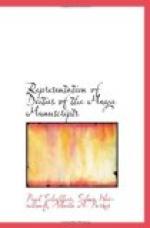The characteristic mark of god F is a single black line usually running perpendicularly down the face in the vicinity of the eye. This line should be distinguished from the parallel lines of C’s face and from the line, which, as a continuation of god E’s head resembling an ear of maize, frequently appears on his face, especially as in the variants of the Madrid manuscript (compare Figs. 25-27). These pictures of E can always be unfailingly recognized by the peculiar shape of the head and should be distinguished from those representing F. The black face-line is the distinguishing mark of god F, just as it is of the Aztec Xipe. It sometimes runs in a curve over the cheek as a thick, black stripe, as Cort. 42. Sometimes it encircles the eye only (Dr. 6a) and again it is a dotted double line (Dr. 6b). The hieroglyph of god F likewise exhibits this line and with the very same variants as the god himself. See the hieroglyphs of the god belonging to the pictures in Dr. 6a, 1st and 3d figures, in which the line likewise differs from the other forms (Figs. 30-34).
In a few places god F is pictured with the same black lines on his entire body, which elsewhere he has only on his face, the lines being like those in Fig. 31, namely Tro. 27*c. Indeed, in Tro. 28*c, the death-god A likewise has these black lines on his body and also F’s line on his face; a clear proof of the close relationship of the two deities. These lines probably signify gaping death-wounds and the accompanying rows of dots are intended to represent the blood.
Since god F is a death-deity the familiar sign (Fig. 5), which occurs so frequently with the hieroglyphs of A, also belongs to his symbols. F is pictured in company with the death-god in connection with human sacrifice (Cort. 42); an exactly similar picture of the two gods of human sacrifice is given in Codex Tro. 30d; here, too, they sit opposite one another. The identity of this attendant of death with the deity, designated by the hieroglyph with the numeral 11, is proved by the following passages: Tro. 19, bottom (on the extreme right hand without picture, only hieroglyph, see Fig. 29), Dr. 5b, 6a, b, and c and many others. In some of the passages cited (Dr. 5a and b) he is distinguished by an unusually large ear-peg. His hieroglyph occurs with the hieroglyph of the death-god in Dr. 6c, where he is himself not pictured.
As war-god, god F occurs combined with the death-god in the passages mentioned above (Tro. 27*-29*c), where he sets the houses on fire with his torch and demolishes them with his spear.
God F occurs quite frequently in the manuscripts and must therefore be considered as one of the more important deities.
According to Foerstemann his day is Manik, the seizing, grasping hand, symbolizing the capturing of an enemy in war for sacrificial purposes.




